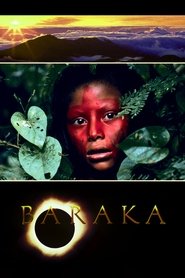Of course, the 'meaning' of Baraka is ultimately to be determined by the viewer, but one can't help but escape the feeling that Ron Fricke's intention in his selection and ordering of montage is to gently critique the modern world. Through his choice and juxtaposition of what he displays, the film seems to lament the encroachment of modernity on the various indigenous peoples it shows. Yet without narration, it gently leads the viewer there; it's not overly didactic, and this is very much to its credit. (Indeed, how much better would David Attenborough's nature documentaries would be if they were like this?)
It is interesting to consider that this kind of cinematography (especially where urban scenes such as Times Square are speeded up 100x) were once a novelty, yet are now a cliché of filmmaking. The stunning images, though, are genuinely beguiling, and this movie went by quickly indeed, even granting that that is a poor metric of good art. I would definitely watch this again at an IMAX, say, and perhaps with 15-20mg of THC…
A film that asks many questions about the Western gaze and how a film can identify with a 'side' (see also Gillo Pontecorvo's Battle of Algiers). Whilst this project seems to be very peak 1990s, it's 'one world, man' political sensibilities (Michael Jackson's 'Earth Song' was to follow in 1995) don't feel it has aged as badly as other similar projects. Still, Roger Ebert's review is well worth looking up, if only because he appears to be captured by the liberal boomer attitude towards race that was around at the time:
There's the indescribable beauty of aborigines, their bodies bearing necklaces, bracelets and body ornaments made from countless tiny beads, their arms and faces painted in intricate patterns of innumerable dots. They dip a cheap plastic comb in paint and rotate it across their skin to leave the dots. Their hypnotic dancing somehow reverberates with the Asian dancers. We see the bright scarlet paint on the brow of a young Amazonian girl, peering solemnly from bright green leaves. A young woman of the Maasai tribe in Kenya, is clothed in a beauty to render "designer fashions" threadbare.
Yes, like the speeded-up nature shots in the film, waxing about the "the indescribable beauty of aborigines" was once the progressive line. Oh, a final shout-out to the sound design — the film is rightly lauded for its imagery, but the sound is absolutely stunning as well, despite the non-diegetic sound being a bit too similar to the music played during a spa treatment.

